 B2C and B2B Marketing: Why Both Are Needed
B2C and B2B Marketing: Why Both Are Needed
For years, healthcare marketers have focused on marketing to consumers — B2C marketing. Providers spent upwards of $10 billion on advertising in 2017, and that figure isn’t likely to drop any time soon. Healthcare organizations’ spending on ads will continue to grow at a rate of about 1.8% each year, reaching $11.56 billion by 2021. $2.1 billion in digital advertising was spent in 2017, and that could reach $2.9 billion by 2021.1
Yet, this book is not about that.
It’s about marketing to physicians, a B2B audience. Why? Consistently overshadowed (and vastly outspent) by service line marketing or institutional branding, the physician audience is not always seen as a priority. Yet, physician referrals are still the primary drivers of volume for most hospitals and health systems — even in this much heralded age of consumer-centric healthcare.
Because of this and other reasons we’ll delve into, it may be a good time to re-assess B2B healthcare marketing. Not as a replacement for B2C marketing, but as a vital adjunct to it.
Physician referrals are still the primary drivers of volume for most hospitals and health systems.
B2B: A Whole Different Animal
B2B audiences are an interesting breed. They are consumers by nature, yet rarely make decisions on impulse. They are highly qualified in their fields, yet are always looking to learn something new. Most B2B sales are “considered sales” — there are enough complexities involved in them for buyers to research different options. For these reasons, many B2B companies employ a sales force in addition to their marketing efforts to help “close” the sale.
In healthcare, it is not uncommon for hospitals to employ physician relations departments as their B2B sales forces. Physician relations performs this function (with the physicians as the customer), along with customer service, consulting, and a few other roles mixed in. In the end, it is their job to build and nurture relationships with referring physicians. Traditionally, this was done through face-to-face encounters — physician liaisons visiting referring physicians’ offices regularly with updates on services and referral materials and to follow up on satisfaction with the referral relationship.
Likewise, when physician liaisons sought to establish a new referral relationship, they made frequent stops into the offices of potential referral partners in the hope of creating a connection, gauging referral potential, distributing educational material, and scheduling face time between the physician they represent and the potential referring physician.
But these face-to-face connections among hospitals, hospital-based physicians, and referring physicians are becoming less frequent. In part this is partially due to some hospitals shrinking or even eliminating their physician liaison programs. However, the work life of the modern physician also plays a role, as does the growth of new technologies and changing preferences in terms of how they receive information.
The implications of this shift are clear: healthcare marketers must be supplemented with new marketing techniques to form a comprehensive physician marketing strategy. Just as B2B companies utilize marketing and sales, so must healthcare providers.
The physician liaison function must be supplemented with new marketing techniques to form a comprehensive physician marketing strategy.
 Reasons to Market to Physicians
Reasons to Market to Physicians
There are a number of reasons healthcare providers market to physicians. Think of them as three Rs:
- Recruitment
We’ve all seen the stats. There will be a shortage of more than 100,000 physicians by 2030.2 Providers around the country are looking for the best ways to market physicians and entice them to call their organizations home. Physician recruitment usually lives in the HR function rather than marketing, but wherever it resides, you first need to hire amazing doctors before you can start advertising for them — or to them. - Reputation
Each summer, U.S. News & World Report releases its influential list of best hospitals in the nation. Like them or hate them, consumers find these rankings useful. As a result, a lot of resources are committed by providers participating in the ranking survey process — to say nothing of the “advertising arms race” that occurs post-publication. According to U.S. News, nearly 30% of their score calculation comes from “expert opinion” — board-certified physicians across the country in the 16 specialties ranked in the Best Hospitals issue. Due to this methodology, physicians have a magnified role in determining hospital reputations. This has led many hospitals to now target them with communications programs designed to increase familiarity and favorability for their institution, service lines, and own top-rated physicians. - Referral
As the healthcare industry becomes more competitive, healthcare providers struggle with referral — including network integrity. Recently, even prominent institutions have seen out-migration rates creep into the double digits. In this environment, keeping physicians informed about your hospital’s strengths (e.g., procedural expertise, key hires, and facilities upgrades) is essential. Hospitals need to communicate these things on a regular basis, but as health systems get larger, connecting with individual doctors becomes harder. This is where marketing comes in.
Even prominent institutions have seen out-migration rates creep into the double digits.
Reputation has a more significant influence on the total U.S. News score than its objective counterparts.
Like or hate them, consumers find these hospital rankings like U.S. News & World Report’s useful in that they give patients information about the institutions they trust with their lives. However, advertising is typically created for and directed to consumers and not physicians. This is significant, because U.S. News’ annual rankings are determined by an index of quality based on objective and subjective measures — and a recent study confirmed reputation has a more significant influence on the total U.S. News score than its objective counterparts.
The Physician Persona
There are about a million practicing physicians in the U.S. and each is highly specialized in their daily work. Many of the things that hold true for marketing to consumers — and even other business audiences — do not for medicine.
Here are some examples3:
THEY DON’T DO DESK
The majority of physicians aren’t sitting in an office each day — their busy schedules have made them one of the first professions in the U.S. to be truly mobile-first.
AN APPLE A DAY
Roughly 85% of doctors are iPhone users, compared to 32.5% of the general population who choose the Apple phone over any Android model.
THEY’RE NETWORKERS
From late-night med school cram sessions to working in multiple clinics or hospitals, doctors rely heavily on professional networking throughout their careers.
PRIVACY RULES
Due to strict HIPAA regulations requiring all patient-related communications to be encrypted, doctors are virtually banned from using email and SMS messaging in their daily work.
SPECIALTY MEANS SPECIALNESS
Much of what physicians practice is extremely specific. Writing something for a cardiologist? Consider whether they are electrophysiologists, interventional cardiologists, or even better, “interventional cardiologists with a focus on coronary artery stents.”
THEY DIFFER (EVEN AMONG THEMSELVES)
Various studies have been done linking medical specialties and Myers-Briggs personality typing. In the one such study, neurosurgeons fell into three personality types (“The Logistician,” “The Commander,” and “The Architect”). Physicians in one specialty may not only differ against the general population, but against other specialties as well.
CONTENT IS KEY
Physicians as a group are highly skeptical, well-informed, and opinionated. They are turned off by consumer-centric messaging and marketing fluff.
The main point we’d like to make is that there are no “cookie-cutter” B2B marketing strategies to physicians. In general, you can focus on mobile instead of desktop advertising, find the right social networks where physicians connect, and make sure your marketing content is up to snuff. But fully addressing their needs can mean going above and beyond these approaches.
Best Practices
Many hospitals are still designing websites for desktop computers and then trying to shoehorn them onto mobile devices.
BE AN INFORMATION PARTNER
Studies have shown that medical professionals prefer marketers to act as information partners.4 Content marketing designed to establish your thought leadership in a specific area(s) builds trust — this is critical for referrals and reputation building. Our clients have told us that developing strong clinical content is their toughest challenge, but it is one that must be met because providing useful, relevant information and education is the best way to not only get their attention, but also to earn credibility.
OPT-IN IS THE GOAL
There are many great channels out there for reaching physicians, however, the costs to use them can spiral to the point of unprofitability. That’s why email is critical. Aside from being a preferred channel by physicians themselves, it is the most costeffective way to communicate on an ongoing basis. Note that this does not mean buying email lists (a worst practice), but rather getting physicians to opt-in to future communications because they value your content or partnering with a trusted distribution source and leveraging their subscriber base.
MOBILE FIRST
Many hospitals are still designing websites for desktop computers and then trying to shoehorn them onto mobile devices. For the physician on a mobile device, your content needs to be concise and clear, and your design minimalist. Additionally, consider using video — an engaging and mobile-friendly format. Also, feature peers rather than patients. Physicians prefer a more clinical perspective when reading about new treatments or technology.
THERE IS NO MAGIC BULLET
Go with what works. If that means using unglamorous newsletters and direct mail, so be it. If it means using the latest programmatic media techniques (using artificial intelligence and real-time bidding techniques to target physicians wherever they go on the web) or geofencing conferences (sending relevant messages to smartphone users who enter a predefined location), do that. Marketing to physicians is an imperfect science, and what works for one organization may not work as well for another.
Physicians prefer a more clinical perspective when reading about new treatments or technology.
Putting It in Context
CONTEXTUAL ADVERTISING is the placement of ad campaigns on websites or site pages that are directly relevant to the ad you’re running.
In B2C, if you’re selling a kitchen mixer, for example, you might try to have it placed on sites listing recipes for cakes. The idea here is that people who are interested in baking are more likely to want a mixer than someone on a video gaming site. A more interested audience usually means better click-through rates and more conversions, so contextual advertising is a great way to improve the performance of your marketing.
- There are now a growing number of advertising- funded sites with content developed specifically for physicians. We will review select ones, but before we do …
- Sites like Twitter, LinkedIn, YouTube, Facebook, and Google are all used by physicians — they are just not contextually in sync with them. The sites we will cover all reach physicians, but they are utilized differently. A news site is likely to be visited by physicians 2–3 times a week, while a reference site is likely to used 2–3 times a day.5
- These sites do not represent the beginning and end of physician communications. According to a 2018 HealthLink Dimensions survey of more than 700 physicians, email followed by interactions via in-person visits (remember those physician liaisons?) and direct mail are still the preferred channel for receiving industry news, announcements, research, and educational opportunities.
Capturing physician attention and persuading them to change long-standing referral patterns or opinions about particular institutions usually takes a concerted, omni-channel effort to succeed. Look at the sites on the next pages as set of digital marketing tools that enable you to pursue that effort in contextually relevant way.
The sites we will cover all reach physicians, but they are utilized differently. A news site is likely to be visited by physicians 2–3 times a week, while a reference site is likely to used 2–3 times a day.5
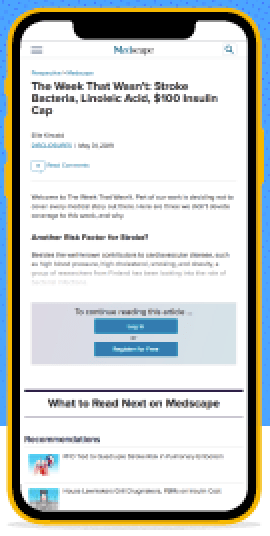 Medscape
Medscape
Think of Medscape as The New York Times of medicine. It is a premier source for medical news, clinical reference, point-of-care tools, and medical education for physicians. Owned by WebMD, Medscape boasts a 55% physician reach on mobile. Its precision targeting and ability to present brand messages to physicians through the flow of their day (apps, site, tools) and across devices make it a go-to resource for B2B healthcare marketing.
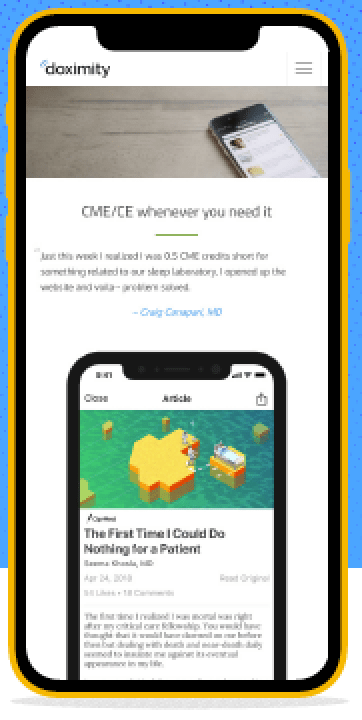 Doximity
Doximity
While doctors are highly social, you won’t find them connecting to each other on Facebook or LinkedIn, at least for their day-to-day work — that’s where Doximity comes in. Billing itself as the “newsfeed of medicine,” Doximity’s fast-growing audience now exceeds that of the AMA — it has over 1 million members. While it (proudly) does not allow banner ads, it offers marketers an effective media mix through its Colleague Connect® and DocNews® products.
 SERMO
SERMO
If Doximity is the LinkedIn of medicine, SERMO is the Facebook. This social media site acts as a virtual doctors’ lounge in which practitioners vent about anything and everything. Since 90% of SERMO’s users remain anonymous, the site’s medical crowdsourcing feature does not run afoul of privacy laws. Much of the current advertising is from pharma companies, but that could change if this intriguing functionality takes off.
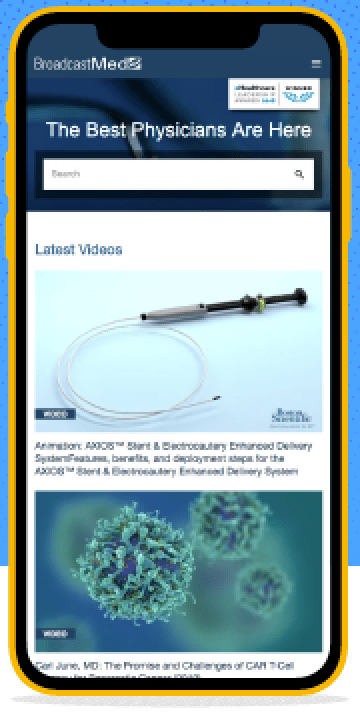 BroadcastMed
BroadcastMed
A recent Johns Hopkins study found that YouTube was the most valued social media channel by physicians — not surprising considering the instructional power of video.6 BroadcastMed, a contextual channel similar to YouTube, was first in the world to broadcast live surgeries on the internet using its ORLive solution and is still going strong after nearly 25 years. It lets industry participants post their educational content and run targeted campaigns towards the physician audience that they’re looking for.
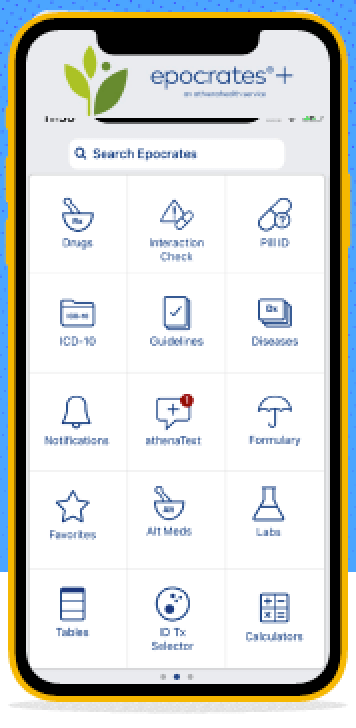 Epocrates
Epocrates
Epocrates is designed for physicians for use at the point of care. App users check drug dosing, drug interactions, drug safety details, medical news, disease diagnosis, and management guidance as well as evidence-based clinical practice guidelines. Epocrates embeds brand messages at multiple points across the care continuum, inside the clinical workflow, when doctors are actively searching (often multiple times a day) for drug and disease state information.
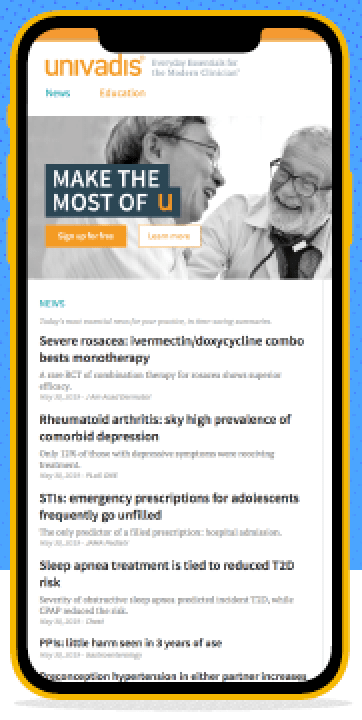 Univadis
Univadis
Univadis uses concise executive summaries to help physicians tame the onslaught of medical literature and stay up to date in just a few minutes per day. While the site has morphed a bit — it was started by Merck, and absorbed peer-to-peer physician network QuantiaMD a few years back — its current owner, Aptus Health, has made it a platform that features sponsored content delivered through various market access pull-through programs.
Starting a Pilot Program

The outcomes of a physician marketing program will differ depending on the objective of the program (recall the three Rs). There are basic measurements, however, that can be used across all objectives — engagement, perception, and behavior (see next page). Each of these has different metrics associated with them. Keep them in focus, and be prepared to make adjustments to strategies and tactics if needed. If your organization is new to B2B marketing, it may be beneficial to conduct a pilot program with one or two service lines in order to perfect the process. Pairing with an experienced partner can help as well.
For over 30 years, Movéo has worked in only two market sectors — B2B and B2C healthcare. Physician marketing, whether it be for a hospital, health system, or a medical manufacturer, is nothing new to us. It lies at the very intersection of what we do.
Even if you have a B2C agency or a strong internal team, Movéo can bring different experience and perspective to your physician marketing. To learn more, call Sheri Granholm, Senior Vice President of Consulting and Engagement, at 312.487.3621.
Outcomes

ENGAGEMENT
B2B digital programs are highly measurable. Primary metrics include REACH (impressions delivered), RESPONSE (clicks and visits) INTERACTION (time spent, link activity), and AMPLIFICATION (content shared with colleagues).
PERCEPTION
Perceptual metrics can take time to change. Initial benchmark and post-campaign quantitative research can measure positive trend in FAMILIARITY, FAVORABILITY, and INTENT.
BEHAVIOR
Desired behaviors — increased referral, network integrity, or institutional ranking, for example — typically lag behind engagement and perception changes. Although accretive, gains can be significant and long lasting.
Movéo is a demand generation agency uniquely built to help its clients measurably improve business performance. We focus on three interdependent drivers of growth –– branding, lead generation, and customer engagement –– to attract, secure, and retain profitable customers for our clients.
To read more of our thought leadership, visit moveo.com.
1 Source: 2017 BIA/Kelsey report
2 Source: Association of American Medical Colleges study released March 14, 2017
3 Source: MediaPost, “5 Things You Don’t Know About Marketing To Doctors,” January 12, 2015
4 Source: 2016 HealthLink Dimensions survey
5 Sources & Interactions: 2017 Medical/Surgical Edition Dashboard Copyright © 2017 KANTAR MEDIA
6 Source: Johns Hopkins “Physician Communication: Inform Strategy through Research,” May 2017





